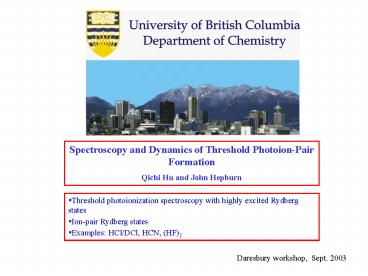Spectroscopy and Dynamics of Threshold PhotoionPair Formation - PowerPoint PPT Presentation
1 / 29
Title:
Spectroscopy and Dynamics of Threshold PhotoionPair Formation
Description:
Threshold photoionization spectroscopy with highly excited Rydberg states ... From: Sheasley and Mathews, J. Mol. Spec. 47, 420 (1973) ... – PowerPoint PPT presentation
Number of Views:42
Avg rating:3.0/5.0
Title: Spectroscopy and Dynamics of Threshold PhotoionPair Formation
1
Spectroscopy and Dynamics of Threshold
Photoion-Pair Formation Qichi Hu and John Hepburn
- Threshold photoionization spectroscopy with
highly excited Rydberg states - Ion-pair Rydberg states
- Examples HCl/DCl, HCN, (HF)2
Daresbury workshop, Sept. 2003
2
Conventional PES recorded with HeI lamp and
electron monochromator. Resolution about 2meV
(16cm-1). For H2 some rotational structure can be
resolved
ZEKE (zero kinetic energy) PES of H2, showing the
v8 band. Rotational structure is fully
resolved, resolution is 0.12meV (1cm-1)
3
Pulsed field ionization spectroscopy
Long lived high n Rydberg states are excited with
a VUV laser. A delayed pulsed field is used to
detect the Rydberg states. For pulsed fields,
Rydberg states within ?4?F of the ionization
limit are detected. Delay can be used to apply
discrimination fields, either e- or ions can be
detected.
4
Highly excited vibrational levels in ion-pair
states
5
(No Transcript)
6
(No Transcript)
7
First TIPP Spectrum O2 ? O O-Martin,
Hepburn, Phys. Rev. Lett., 79, 3154-3157 (1997)
8
Applications of TIPPS 1. Determine the bond
dissociation energies of molecules
AB hv ? A --- B- ?EIP
D0(AB) ?EIP - IP(A) EA(B) 2. Get
energetic information about fragment ions
ABC hv ? A --- BC- 3. Obtain
dynamical information about the dissociation
process into ion-pairs Difficulties with
TIPPS 1. Generation of XUV/VUV 2. Low
cross-section to ion-pair states (10-2 or less
compared to ionization process)
9
Born Cycle for HCl/DCl Bond Energies
- HX systems are ideal for testing BO breakdown and
direct fits of potentials to spectroscopic data - TIPPS provides highly accurate measure of D0(H-X)
and thus De - Main source of error for these systems is
extrapolation to zero field for ?EIP
10
Born-Oppenheimer Breakdown Corrections
- Spectroscopic data fit to effective hamiltonian
- Last term adiabatic correction to BO potential,
main breakdown term - TIPPS directly measures the total of this
correction for different isotopomers
11
HCl and DCl TIPP Spectra
- Spectra recorded under same field conditions
- Compare blue edges for all J lines
12
Results for HCl/DCl
- a calculated from 2V/cm
- b Martin and Hepburn, J. Chem. Phys. 109, 8139
(1998) - c Coxon and Hajigeorgiou, J. Mol. Spec. 203
(2000) statistical error from fit
De(H-Cl) - De(H-Cl) 3.21.0 cm-1 (CH 8.8
cm-1) De(H-Cl) - De(H-Cl) -7.52.0 cm-1
13
HF Total photoion pairs and TIPPS
- In both PIE and TIPP spectra there are numerous
resonances. - This resonant enhancement of the ion-pair yield
comes from Franck-Condon allowed transitions to
Rydberg states which are coupled to the ion-pair
(pseudo) continuum
14
Mechanism for PhotoIon-Pair Formation in HF,HCl
- Franck-Condon allowed excitation to Rydberg
states - Predissociation by B1S ion-pair state
In HF A2S state much shallower than in HCl
From Sheasley and Mathews, J. Mol. Spec. 47, 420
(1973)
15
Simulation of HCl Total PhotoIon-Pair Yield
- Used 1S Rydberg states with HCl A2S ion core
- Additional resonances unassigned, possibly due to
3P or 1P states with same ion core. - Used ab initio quantum defects, experimental
spectroscopic constants.
16
HCN Threshold Photoion-Pairs
- Energetics not reliably known
- Rotational constants known for HCN and CN-
- Rotational quantum number change??
17
H2S TIPPS (R. C. Shiell, X. K. Hu, Q. J. Hu, J.
W. Hepburn, J. Phys. Chem. A, 104, 4339, (2000))
- Essentially no change in J upon dissociation to
H SH- - Consistent with impulsive dissociation
18
H- SH channel
- Need to have very large changes in J to simulate
spectrum (??J?gt10) - Coincidentally similar to H2S dissociation at
121.6nm
19
HCN Ion-pair yield spectrum
H signal (arb. un.)
0
200
400
600
800
XUV 121800 /cm-1
TOF spectra _at_ 15.35 eV
signal (arb. un.)
HHCN ? 0.015 (for H2S, ratio is 0.1)
R H x 50 (w) x 130 (h) B HCN
20
TIPP Spectrum
R strong XUV B weak XUV
H signal (arb. un.)
300
400
600
700
500
XUV 122000 /cm-1
21
Simulation of TIPPS spectrum
R simulation B experiment
H signal (arb. un.)
300
400
600
700
500
800
900
XUV 122000 /cm-1
- Preliminary results
- IPD(H-CN) 122509 3 cm-1
- ?J peaks at 4
22
Other simulations of TIPPS spectrum
?J 8
H signal (arb. un.)
?J 0
300
400
600
700
500
800
900
XUV 122000 /cm-1
23
HCN TIPP Spectrum
24
HF, (HF)2 Energetics
25
HF and H2F TOF spectra
26
(No Transcript)
27
- HF Clusters
- (HF)2 never observed in photoionization
- Possible mechanism for resonances
- HFHF h? ? HFHF
- ? HFH F e-
- ? HFH F-
- Both channels can lead to high n Rydberg states
(electronic or ion-pair) which can be pulse field
ionized. - Signals observed for larger clusters H3F2,
H4F3, etc. - Pulsed field ionization signal has been observed
for H3F2 has been observed in the same photon
energy range. - Although resonances reflect Rydberg states of
(HF)2, the PFI signals reflect ionization
thresholds of HFH at very high levels of
vibrational excitation in the proton transfer
reaction coordinate.
28
Detail of H2F threshold spectrum
H2F signal (arb. un.)
15.1
15.9
15.7
15.5
15.3
VUV energy (eV)
H2F signal (arb. un.)
15.31
15.39
15.37
15.35
15.33
VUV energy (eV)
29
Vibrational bands observed in H2F threshold
spectrum
H2F signal (arb. un.)
0.42 eV
0.17 eV
0.42 eV
15.1
15.9
15.7
15.5
15.3
VUV energy (eV)
Vibrational frequencies of H2F
V1(symmetric stretch) 3348.7078 cm-1
V3(anti-symmetric stretch) 3334.6895
cm-1 V2(bend) 1398
cm-1
(0.415 eV) (0.413 eV) (0.173 eV)
Reference 1 E. Schäfer, and R. J. Saykally,
J. Chem. Phys. 81, 4189 (1984)































